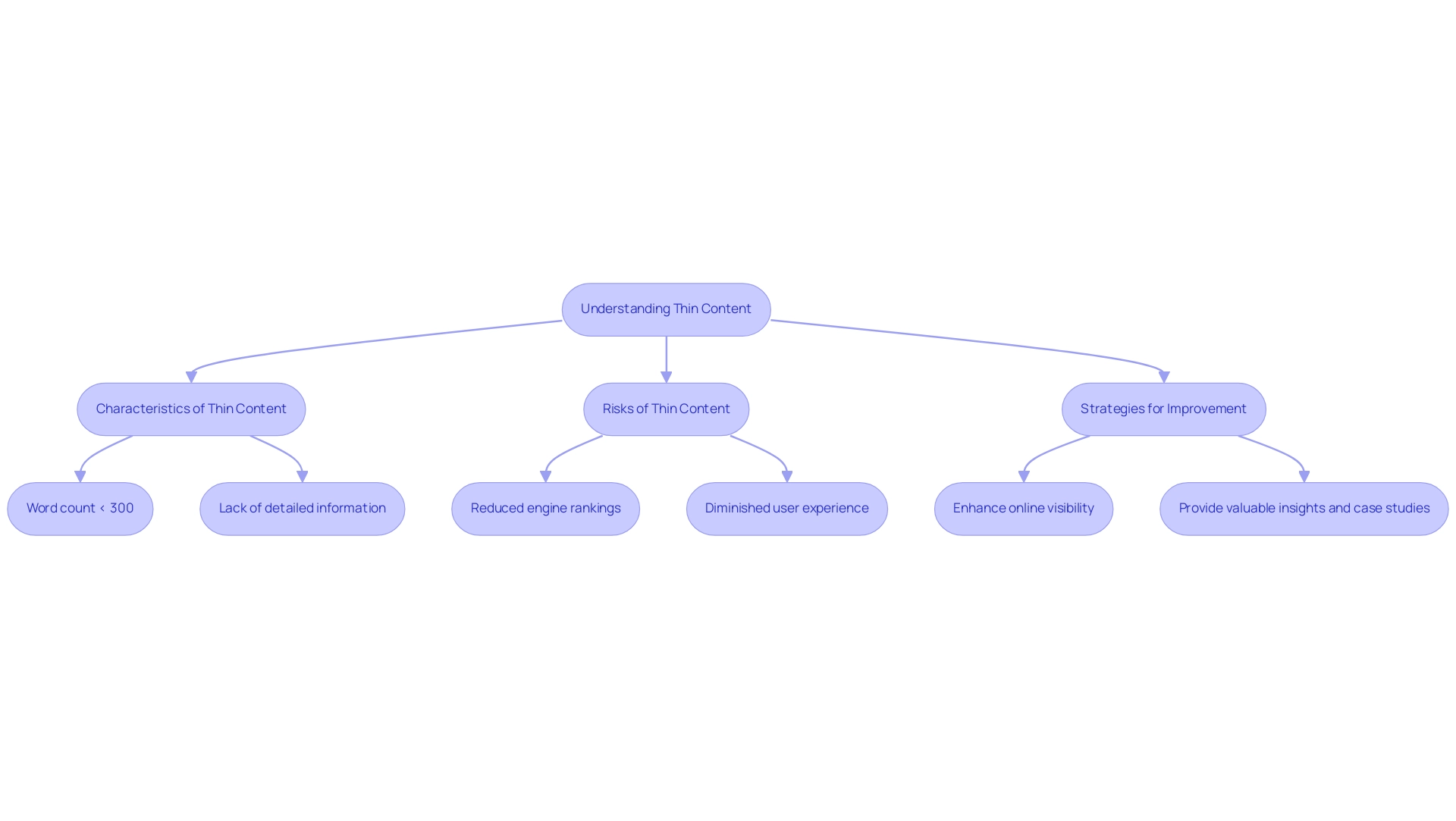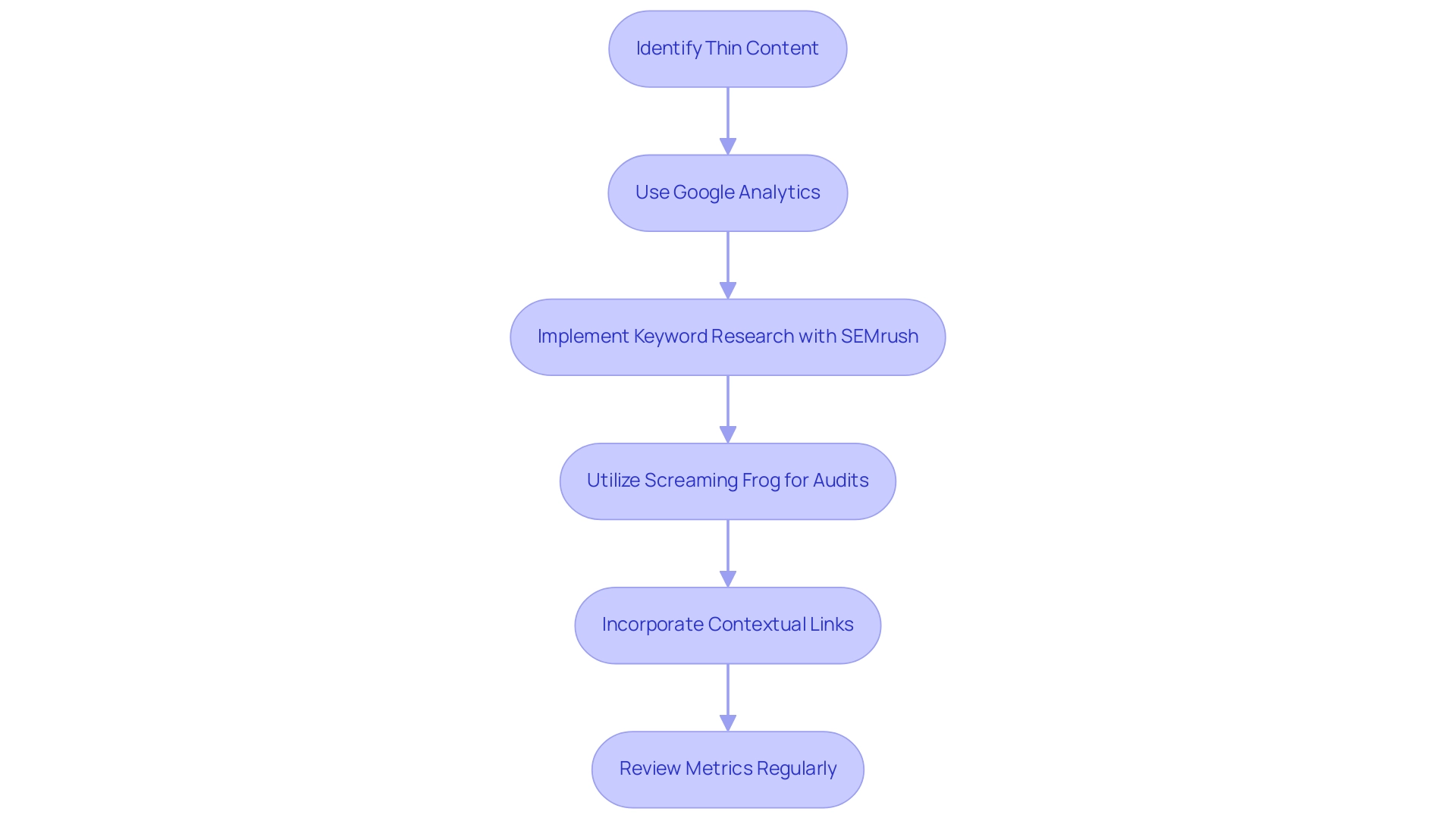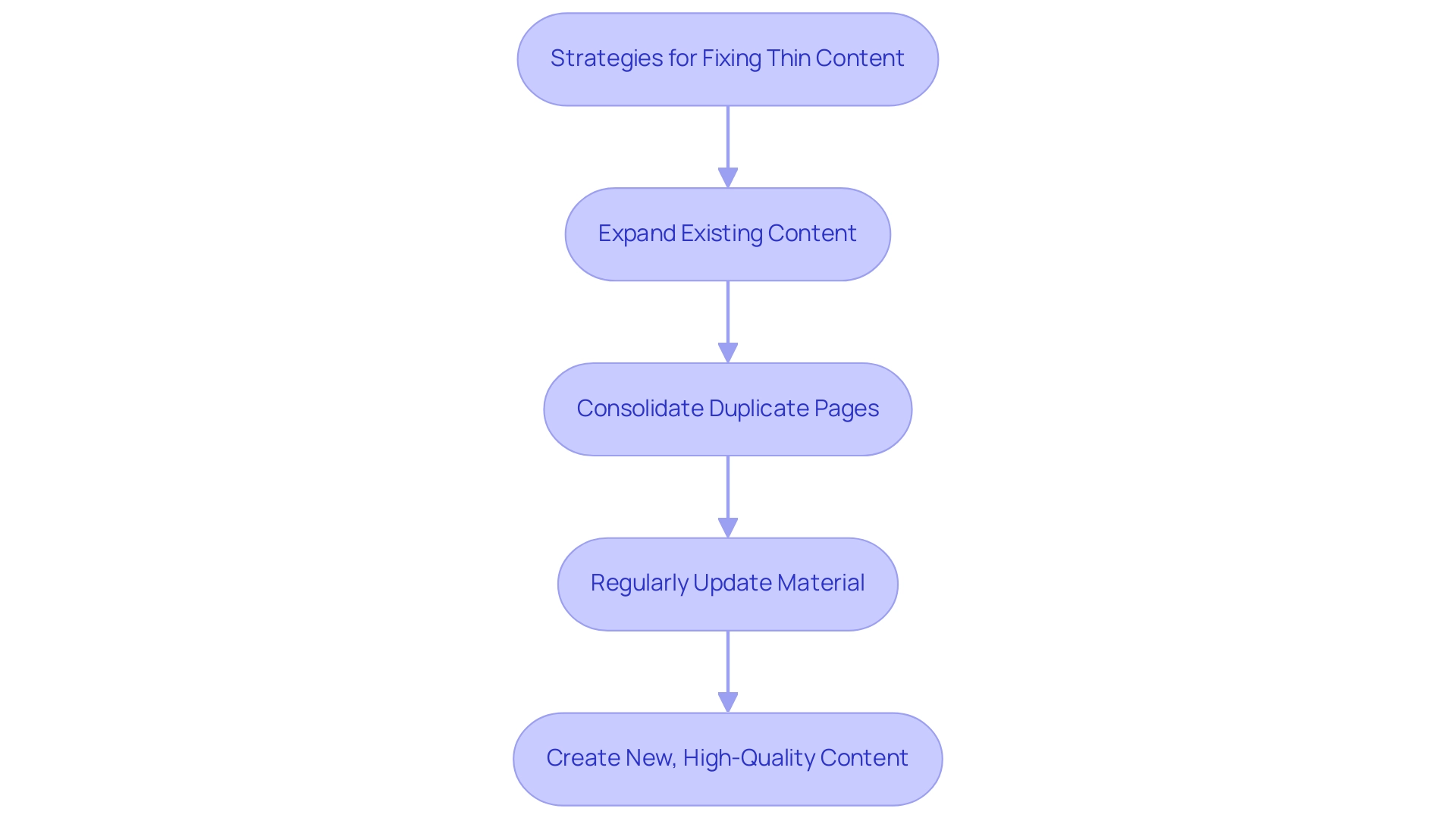Introduction
In the competitive landscape of digital marketing, the quality of content can make or break a healthcare organization’s online presence. Thin content—characterized by its lack of depth and minimal value—poses a significant risk to search engine rankings and user engagement. As search engines evolve to prioritize comprehensive and relevant information, clinics must recognize the importance of addressing thin content to enhance their visibility and attract potential patients.
This article delves into the following topics:
- Definition of thin content
- Tools and techniques for identifying thin content
- Common pitfalls that can harm SEO
- Effective strategies for remediation
- Long-term benefits of maintaining high-quality content
By understanding and addressing these challenges, healthcare providers can significantly improve their online presence and foster trust with their audience.
Understanding Thin Content: Definition and Importance in SEO
Websites that exhibit thin-content SEO are characterized as those that do not provide significant value to users, often marked by a word count of fewer than 300 words and a lack of detailed information. Such material does not satisfy the standards of engines that prioritize comprehensive and relevant pages, as it may lead to thin-content SEO and ultimately diminish user experience. As a result, websites with thin-content SEO risk reduced engine rankings, making it essential for healthcare organizations to tackle this issue.
As noted, ‘28% of searches for something nearby result in a purchase’ (Think With Google), underscoring the necessity for clinics to enhance their online visibility through quality material. Additionally, SEOs typically take 1-2 hours to build a single link, highlighting the investment required to improve SEO efforts. By providing valuable insights, original data, and case studies, such as the one titled ‘Increasing Organic Visibility for Dent Repair Services,’ healthcare providers can significantly improve their SEO health and establish trust with potential patients.
This foundational understanding of thin-content SEO is essential for clinics aiming to elevate their online presence and attract more patients.

How to Identify Thin Content: Tools and Techniques
To effectively identify thin-content SEO on your website, it is essential to leverage robust analytical tools such as Google Analytics and SEMrush. Start your evaluation by concentrating on sections that display low traffic and high bounce rates, as these metrics often indicate insufficient user engagement. Using Google Analytics allows you to examine audience demographics and identify which sections are underperforming.
Furthermore, implementing a keyword research strategy using SEMrush’s Keyword Magic Tool allows for comprehensive keyword research, ensuring your material aligns with user intent and remains pertinent, thereby refocusing on thin-content SEO.
Along with these tools, think about using audit tools such as Screaming Frog, which can scan your website to find pages with thin-content SEO or minimal unique material. This process helps in pinpointing areas that require enhancement. According to recent insights, material exceeding 3,000 words garners 3.5 times more backlinks than articles of average length, underscoring the value of comprehensive material.
Moreover, incorporating contextual links to original sources not only enhances credibility but also signals to Google that your material is well-researched. A case study demonstrates that linking to reputable publishers significantly enhanced authority and improved SEO outcomes. As Alison Betsinger states, “We’ve been working with JEMSU for about five months and couldn’t be happier with the outcome.
Our traffic is up and our leads are increasing in quality and quantity by the month. My only regret is not finding them sooner! They’re worth every penny!”
This real-world perspective reinforces the effectiveness of these strategies. By regularly reviewing these metrics and employing the aforementioned tools, you can maintain a high-quality website that meets the evolving standards of SEO.

Common Types of Thin Content That Harm SEO
Thin material encompasses several detrimental types that can significantly undermine your website’s SEO performance.
- Replicated Material: The existence of comparable or identical material across various sections can create confusion for search engines, leading to diluted rankings.
As highlighted by Jimmy Rodela, Syndication is the process of re-publishing an existing post to another website or platform; however, when mismanaged, it can exacerbate duplicate issues. Statistics indicate that if a site has 16,000 or 160,000 indexed pages, it may suggest that numerous pages have been added automatically, which can lead to significant thin material issues.
-
Low-Quality Blog Posts: Articles lacking depth, particularly those under 300 words, often fail to provide substantial value to readers. Such posts not only disengage your audience but also indicate to search engines that the material may not be worth ranking.
-
Landing Pages with Minimal Information: Pages intended to showcase specific services that do not elaborate adequately can deter potential patients. Inadequate material may result in a missed chance to engage with your audience.
-
Content Farms: Websites that produce large volumes of low-quality articles primarily to attract traffic can severely hamper SEO efforts. A case study titled ‘Types of Duplicate Material Leading to Penalties’ illustrates how certain types of duplicate material, such as misconfigured syndicated material, can negatively impact SEO. Furthermore, Patel dispels common myths about duplicate material, including the misconception that it always hurts search rankings, highlighting the need for a nuanced understanding of this issue.
The rise of sophisticated material treatment has made it imperative to focus on creating a healthier ecosystem. Identifying and addressing these thin materials on your site is essential for enhancing SEO performance and ensuring compliance with best practices.

Effective Strategies for Fixing Thin Content
To effectively tackle thin material issues, consider implementing the following strategies:
- Expand Existing Content: Enrich underperforming sections by incorporating detailed information, relevant images, and supporting data. Aim for a minimum of 800 words to create comprehensive articles that thoroughly address the topic.
This approach is essential, particularly given that the Google Ad Grant Program has delivered over $9 billion in free advertising to nonprofits, highlighting the need for effective strategies.
- Consolidate Duplicate Pages: Unify similar pages into a single authoritative resource.
This not only enhances SEO but also improves user experience by reducing confusion and providing clear, consolidated information.
- Regularly Update Material: Periodically refresh outdated material by adding new insights and updating information.
As emphasized in the case study named ‘Staying Current with SEO Trends,’ consistently updating SEO knowledge and using tools guarantees that material stays optimized and competitive in rankings. This practice is crucial for retaining SEO benefits and ensuring that thin-content SEO remains relevant to current trends and user needs.
- Create New, High-Quality Content: Develop in-depth articles, guides, and resources that address common patient questions and concerns.
This proactive approach is essential for significantly improving your site’s performance in thin-content SEO. Remember, as Andy Crestodina stated, ‘Although meta keywords are totally useless, the meta description remains important.’
Applying these strategies will assist in guaranteeing that your clinic’s online presence is strong and competitive in rankings.

The Long-Term Benefits of Addressing Thin Content Issues
Addressing thin material issues provides numerous long-term advantages that can significantly enhance your clinic’s digital presence:
-
Enhanced Visibility in Engine Rankings: High-caliber, comprehensive material is progressively preferred by engines, leading to improved visibility and a related rise in organic traffic. Notably, long-form blog posts have been shown to generate more leads compared to shorter materials, particularly in B2B settings, where detailed, informative resources align well with complex buyer journeys. Furthermore, with 87.6% of Google search results featuring minimal to no AI material, addressing thin-content SEO by producing original, high-quality work is crucial for enhancing search engine rankings.
-
Enhanced User Experience: Offering valuable, well-researched information fosters trust and engagement among potential patients. When users discover material that meets their needs, they are more likely to engage positively with your clinic.
-
Increased Conversion Rates: According to recent statistics, visitors who encounter well-crafted and relevant material are more likely to convert into patients. This trend emphasizes the importance of delivering helpful resources to improve overall conversion metrics.
-
Sustained Brand Authority: Regularly updating and enhancing your materials not only positions your healthcare organization as an authority in your field but also attracts a continuous influx of visitors over time. By consistently prioritizing quality of material, you establish a strong foundation for long-term success in a competitive digital landscape, which helps to mitigate the risks associated with thin-content SEO. Notably, on average, Google AI Overviews contain 4,342 characters, highlighting the depth of content that search engines favor.
As evidenced by a 2021 American Express article, while SEO may offer a slower return on investment compared to paid advertising channels, its cost-effectiveness and potential for sustained growth make it a strategic choice for clinic owners focused on long-term benefits in 2024 and beyond.

Conclusion
Enhancing the quality of content is essential for healthcare organizations seeking to improve their online presence and attract potential patients. Thin content, characterized by its lack of depth and value, poses significant risks to both search engine rankings and user engagement. By understanding the definition of thin content and utilizing tools such as Google Analytics and SEMrush, clinics can identify underperforming pages and take decisive action.
Addressing thin content involves recognizing common pitfalls, such as:
- Duplicate content
- Low-quality blog posts
- Insufficient landing pages
By implementing effective strategies—such as expanding existing content, consolidating duplicate pages, and regularly updating information—healthcare providers can significantly improve their SEO performance. The benefits of these actions extend beyond immediate visibility; they foster trust, enhance user experience, and ultimately lead to increased conversion rates.
In the long run, maintaining high-quality content not only improves search engine rankings but also establishes a clinic as an authority in its field. This commitment to quality is crucial in a competitive digital landscape, where the demand for comprehensive and relevant information continues to grow. By prioritizing content quality, healthcare organizations can create a robust online presence that resonates with potential patients, ensuring sustained success well into the future.

